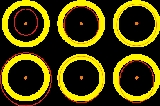
Mars-crosser asteroid
Encyclopedia
A Mars-crosser is an asteroid
whose orbit
crosses that of Mars
. The known numbered Mars-crossers are listed here. They include the two numbered Mars trojans 5261 Eureka
and .
Many databases, for instance the Jet Propulsion Laboratory
's online Small-Body Database Browser, only list asteroids with a perihelion greater than 1.3 AU
as Mars-crossers. An asteroid with a perihelion less than this is classed as a near-Earth object
instead, even though it is crossing the orbit of Mars as well as crossing (or coming near to) that of Earth. Nevertheless, these objects are listed on this page. A grazer is an object with a perihelion below the aphelion of Mars (1.67 AU) but above the Martian perihelion (1.58 AU).
Mars-crossers that are also Earth-crossers or grazers
These objects are not catalogued as Mars-crossers in databases such as the Jet Propulsion Laboratory
's online Small-body Database Browser. Instead, they are categorized as Near Earth Objects (NEOs).
Asteroid
Asteroids are a class of small Solar System bodies in orbit around the Sun. They have also been called planetoids, especially the larger ones...
whose orbit
Orbit
In physics, an orbit is the gravitationally curved path of an object around a point in space, for example the orbit of a planet around the center of a star system, such as the Solar System...
crosses that of Mars
Mars
Mars is the fourth planet from the Sun in the Solar System. The planet is named after the Roman god of war, Mars. It is often described as the "Red Planet", as the iron oxide prevalent on its surface gives it a reddish appearance...
. The known numbered Mars-crossers are listed here. They include the two numbered Mars trojans 5261 Eureka
5261 Eureka
5261 Eureka is the first asteroid discovered that turned out to be a Mars trojan asteroid. It was discovered by David H. Levy and Henry Holt at Palomar Observatory on June 20, 1990. It trails Mars at a distance varying by only 0.3 AU during each revolution...
and .
Many databases, for instance the Jet Propulsion Laboratory
Jet Propulsion Laboratory
Jet Propulsion Laboratory is a federally funded research and development center and NASA field center located in the San Gabriel Valley area of Los Angeles County, California, United States. The facility is headquartered in the city of Pasadena on the border of La Cañada Flintridge and Pasadena...
's online Small-Body Database Browser, only list asteroids with a perihelion greater than 1.3 AU
Astronomical unit
An astronomical unit is a unit of length equal to about or approximately the mean Earth–Sun distance....
as Mars-crossers. An asteroid with a perihelion less than this is classed as a near-Earth object
Near-Earth object
A near-Earth object is a Solar System object whose orbit brings it into close proximity with the Earth. All NEOs have a perihelion distance less than 1.3 AU. They include a few thousand near-Earth asteroids , near-Earth comets, a number of solar-orbiting spacecraft, and meteoroids large enough to...
instead, even though it is crossing the orbit of Mars as well as crossing (or coming near to) that of Earth. Nevertheless, these objects are listed on this page. A grazer is an object with a perihelion below the aphelion of Mars (1.67 AU) but above the Martian perihelion (1.58 AU).
Co-orbital
- 5261 Eureka5261 Eureka5261 Eureka is the first asteroid discovered that turned out to be a Mars trojan asteroid. It was discovered by David H. Levy and Henry Holt at Palomar Observatory on June 20, 1990. It trails Mars at a distance varying by only 0.3 AU during each revolution...
—the only named Mars trojan—the only other numbered Mars trojan—co-orbital with Mars
Mars-crossers that are also Earth-crossers or grazersEarth-crosser asteroidAn Earth-crosser is a near-Earth asteroid whose orbit crosses that of Earth as observed from the ecliptic pole of Earth's orbit. The known numbered Earth-crossers are listed here. Those Earth-crossers whose semi-major axes are smaller than Earth's are Aten asteroids; the remaining ones are Apollo...
These objects are not catalogued as Mars-crossers in databases such as the Jet Propulsion LaboratoryJet Propulsion Laboratory
Jet Propulsion Laboratory is a federally funded research and development center and NASA field center located in the San Gabriel Valley area of Los Angeles County, California, United States. The facility is headquartered in the city of Pasadena on the border of La Cañada Flintridge and Pasadena...
's online Small-body Database Browser. Instead, they are categorized as Near Earth Objects (NEOs).
See also
- List of Mercury-crossing minor planets
- List of Venus-crossing minor planets
- List of Earth-crossing minor planets
- List of Jupiter-crossing minor planets
- List of Saturn-crossing minor planets
- List of Uranus-crossing minor planets
- List of Neptune-crossing minor planets

